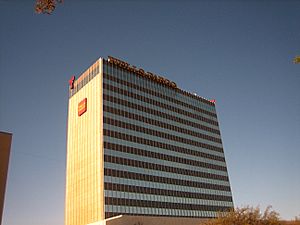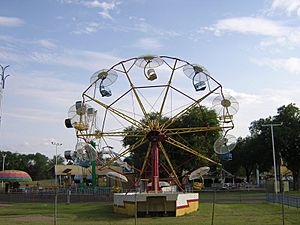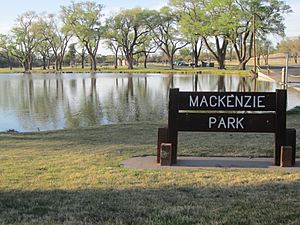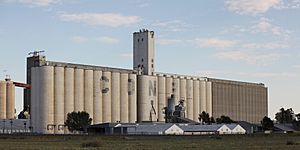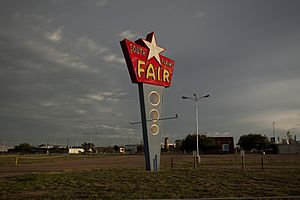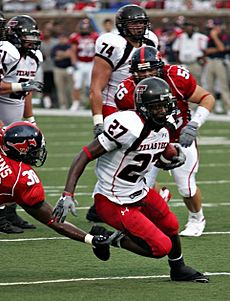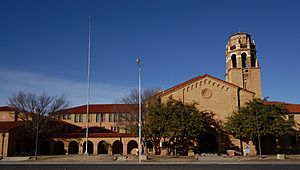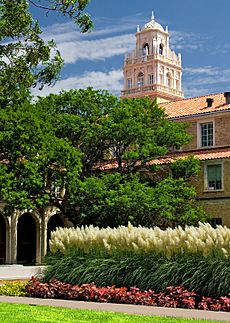Lubbock, Texas facts for kids
Quick facts for kids
Lubbock, Texas
|
|||
|---|---|---|---|
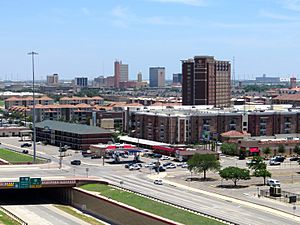
Downtown Lubbock in 2013
|
|||
|
|||
| Nickname(s):
"Hub City"
|
|||
| Country | |||
| State | Texas | ||
| County | Lubbock | ||
| Settled | 1889 | ||
| Incorporated | March 16, 1909 | ||
| Named for | Thomas Saltus Lubbock | ||
| Government | |||
| • Type | Council–manager | ||
| Area | |||
| • City | 135.85 sq mi (351.84 km2) | ||
| • Land | 134.60 sq mi (348.62 km2) | ||
| • Water | 1.24 sq mi (3.22 km2) | ||
| Elevation | 3,202 ft (976 m) | ||
| Population
(2020)
|
|||
| • City | 258,871 | ||
| • Density | 1,905.56/sq mi (735.763/km2) | ||
| • Metro | 314,840 | ||
| • CSA | 340,119 | ||
| Demonym(s) | Lubbockite | ||
| Time zone | UTC−6 (CST) | ||
| • Summer (DST) | UTC−5 (CDT) | ||
| ZIP Codes |
79401-79416, 79423, 79424, 79430, 79452, 79453, 79457, 79464, 79490, 79491, 79493, 79499
|
||
| Area code | 806 | ||
| FIPS code | 48-45000 | ||
| GNIS feature ID | 1374760 | ||
| Interstates | |||
| U.S. Routes | |||
Lubbock ( LUB-ək) is the 11th-most populous city in the U.S. state of Texas and the county seat of Lubbock County. The population of 257,141 in 2020, the city is also the 86th-most populous in the United States. The city is in the northwestern part of the state, a region known historically and geographically as the Llano Estacado, and ecologically is part of the southern end of the High Plains, lying at the economic center of the Lubbock metropolitan area, which has an estimated population of 327,424 in 2020.
Lubbock's nickname, "Hub City", derives from it being the economic, educational, and health-care hub of the multicounty region, north of the Permian Basin and south of the Texas Panhandle, commonly called the South Plains. The area is the largest contiguous cotton-growing region in the world and is heavily dependent on water from the Ogallala Aquifer for irrigation.
Lubbock is home to Texas Tech University, the sixth-largest college by enrollment in the state.
Contents
History
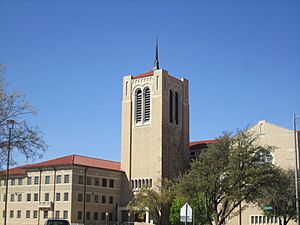
Lubbock County was founded in 1876. It was named after Thomas Saltus Lubbock, former Texas Ranger and brother of Francis R. Lubbock, governor of Texas during the Civil War. As early as 1884, a federal post office existed in Yellow House Canyon. A small town, known as Old Lubbock, Lubbock, or North Town, was established about three miles to the east. In 1890, the original Lubbock merged with Monterey, another small town south of the canyon. The new town adopted the Lubbock name. The merger included moving the original Lubbock's Nicolett Hotel across the canyon on rollers to the new townsite. Lubbock became the county seat in 1891, and was incorporated on March 16, 1909. In the same year, the first railroad train arrived.
Texas Technological College (now Texas Tech University) was founded in Lubbock in 1923. A separate university, Texas Tech University Health Sciences Center, opened as Texas Tech University School of Medicine in 1969. Both universities are now overseen by the Texas Tech University System, after it was established in 1996 and based in Lubbock. Lubbock Christian University, founded in 1957, and Sunset International Bible Institute, both affiliated with the Churches of Christ, have their main campuses in the city. South Plains College and Wayland Baptist University operate branch campuses in Lubbock.
At one time, Lubbock was home to Reese Air Force Base located 6 miles (10 kilometers) west of the city. The base's primary mission throughout its existence was pilot training. The base was closed 30 September 1997 after being selected for closure by the Base Realignment and Closure Commission in 1995 and is now a research and business park called Reese Technology Center.
The city is home to the Lubbock Lake Landmark, part of the Museum of Texas Tech University. The landmark is an archaeological and natural history preserve at the northern edge of the city. It shows evidence of almost 12,000 years of human occupation in the region. the National Ranching Heritage Center, also part of the Museum of Texas Tech University, houses historic ranch-related structures from the region.
In August 1951, a V-shaped formation of lights was seen over the city. The "Lubbock Lights" series of sightings received national publicity and is regarded as one of the first great UFO cases. The sightings were considered credible because they were witnessed by several respected science professors at Texas Technological College and were photographed by a Texas Tech student. The photographs were reprinted nationwide in newspapers and in Life magazine. Project Blue Book, the US Air Force's official investigation of the UFO mystery, concluded the photographs were not a hoax and showed genuine objects, but dismissed the UFOs as being either "night-flying moths" or a type of bird called a plover reflected in the nighttime glow of Lubbock's new street lights. However, other researchers have disputed these explanations, and for many, the "Lubbock Lights" remain a mystery.
In 1960, the Census Bureau reported Lubbock's population as 128,691 and area as 75.0 sq mi (194 km2).
On May 11, 1970, the Lubbock Tornado struck the city. Twenty-six people died, and damage was estimated at $125 million. The Metro Tower (NTS Building), then known as the Great Plains Life Building, at 274 ft (84 m) in height, is believed to have been the tallest building ever to survive a direct hit from an F5 tornado. Then Mayor Jim Granberry and the Lubbock City Council, which included Granberry's successor as mayor, Morris W. Turner, were charged with directing the rebuilding of downtown Lubbock in the aftermath of the storm.
In 2009, Lubbock celebrated its centennial. The historians Paul H. Carlson, Donald R. Abbe, and David J. Murrah co-authored Lubbock and the South Plains.
On August 12, 2008, the Lubbock Chamber of Commerce announced they would lead the effort to get enough signatures to have a vote on allowing county-wide packaged alcohol sales. The petition effort was successful and the question was put to the voters. On May 9, 2009, Proposition 1, which expanded the sale of packaged alcohol in Lubbock County, passed by a margin of nearly two to one, with 64.5% in favor. Proposition 2, which legalized the sale of mixed drinks in restaurants county-wide, passed with 69.5% in favor. On September 23, 2009, The Texas Alcoholic Beverage Commission issued permits to more than 80 stores in Lubbock. Prior to May 9, 2009, Lubbock County allowed "package" sales of alcohol (sales of bottled liquor from liquor stores), but not "by the drink" sales, except at private establishments such as country clubs. Inside the city limits, the situation was reversed, with restaurants and bars able to serve alcohol, but liquor stores forbidden.
Geography
Lubbock is located at 33.566, −101.887. The official elevation is 3,256 ft (992 m) above sea level, but stated figures range from 3,195 to 3,281 ft (974 to 1,000 m). Lubbock is considered to be the center of the South Plains, and is situated north of the Permian Basin and south of the Texas Panhandle. According to the United States Census Bureau, as of 2010, the city has a total area of 123.55 sq mi (319.99 km2), of which, 122.41 sq mi (317.04 km2) of it (99.07%) is land and 1.14 sq mi (2.95 km2), or (0.93%), is covered by water.
Skyline
The tallest buildings in Lubbock are listed below.
| Rank | Name | Height ft / m |
Floors (Stories) | Year Completed |
|---|---|---|---|---|
| 1 | NTS Tower | 274 / 84 | 20 | 1955 |
| 2 | Wells Fargo Building | 209 / 64 | 15 | 1968 |
| 3 | TTU Media and Communication Building | 208 / 63 | 12 | 1969 |
| 4 | Overton Hotel | 165 / 50 | 15 | 2009 |
| 5 | TTU Architecture Building | 158 / 48 | 10 | 1971 |
| 6 | Citizens Tower | 153 / 46.5 | 11 | 1963 |
| 7 | Park Tower | 150 / 46 | 15 | 1968 |
| – | Caprock Hilton Hotel (demolished) | 144 / 44 | 12 | 1929 |
| 8 | Lubbock County Office Building | 143 / 44 | 12 | 1940 |
| 9 | Pioneer Hotel | 136 / 41.5 | 11 | 1926 |
| 10= | TTU Chitwood Hall | 134 / 41 | 12 | 1967 |
| 10= | TTU Coleman Hall | 134 / 41 | 12 | 1967 |
| 10= | TTU Weymouth Hall | 134 / 41 | 12 | 1967 |
| 13 | Lubbock National Bank Building | 134 / 41 | 10 | 1979 |
| 14 | Covenant Medical Center | 114 / 34.5 | 10 | 1994 |
| 15 | Mahon Federal Building & U.S. Courthouse | 107 / 33 | 8 | 1971 |
| 16 | Victory Tower | 96 / 29 | 8 | 1999 |
Climate
Lubbock has a mild, semiarid climate (Köppen climate classification BSk or BSh). On average, Lubbock receives 18.69 in (475 mm) of rain and 8.2 in (20.8 cm) of snow per year.
In 2013, Lubbock was named the "Toughest Weather City" in America the Weather Channel.
Summers are hot, with 78 days on average of 90 °F (32 °C)+ highs and 7.4 days of 100 °F (38 °C)+ highs, although due to the aridity and elevation, temperatures remain above 70 °F (21 °C) on only a few nights. Amarillo, Texas at 13.5 mph (21.7 km/h; 6.0 m/s), and Lubbock, Texas is the tenth-windiest city in the US at 12.4 mph (20.0 km/h; 5.5 m/s). The highest recorded temperature was 114 °F (46 °C) on June 27, 1994.
Winter days in Lubbock are typically sunny and relatively mild, but nights are cold, with temperatures usually dipping below freezing, and, as the city is located in USDA Plant Hardiness Zone 7, lows reaching 10 °F (−12 °C) occur on 2.5 nights. The lowest recorded temperature was −17 °F (−27 °C) on February 8, 1933.
| Climate data for Lubbock, Texas (1981–2010 normals) | |||||||||||||
|---|---|---|---|---|---|---|---|---|---|---|---|---|---|
| Month | Jan | Feb | Mar | Apr | May | Jun | Jul | Aug | Sep | Oct | Nov | Dec | Year |
| Record high °F (°C) | 87 (31) |
89 (32) |
95 (35) |
104 (40) |
109 (43) |
114 (46) |
109 (43) |
107 (42) |
105 (41) |
100 (38) |
90 (32) |
83 (28) |
114 (46) |
| Average high °F (°C) | 54.1 (12.3) |
58.9 (14.9) |
66.7 (19.3) |
75.4 (24.1) |
83.8 (28.8) |
90.6 (32.6) |
92.8 (33.8) |
91.3 (32.9) |
84.5 (29.2) |
75.2 (24.0) |
63.6 (17.6) |
54.1 (12.3) |
74.3 (23.5) |
| Average low °F (°C) | 26.4 (−3.1) |
30.1 (−1.1) |
37.0 (2.8) |
45.7 (7.6) |
55.9 (13.3) |
64.2 (17.9) |
67.7 (19.8) |
66.6 (19.2) |
58.8 (14.9) |
47.9 (8.8) |
35.9 (2.2) |
27.1 (−2.7) |
47.0 (8.3) |
| Record low °F (°C) | −16 (−27) |
−17 (−27) |
−2 (−19) |
18 (−8) |
27 (−3) |
39 (4) |
49 (9) |
43 (6) |
33 (1) |
18 (−8) |
−1 (−18) |
−2 (−19) |
−17 (−27) |
| Average precipitation inches (mm) | 0.65 (17) |
0.75 (19) |
1.10 (28) |
1.41 (36) |
2.30 (58) |
3.04 (77) |
1.91 (49) |
1.91 (49) |
2.51 (64) |
1.93 (49) |
0.85 (22) |
0.76 (19) |
19.12 (486) |
| Average snowfall inches (cm) | 2.6 (6.6) |
1.6 (4.1) |
0.6 (1.5) |
0.2 (0.51) |
0.0 (0.0) |
0.0 (0.0) |
0.0 (0.0) |
0.0 (0.0) |
0.0 (0.0) |
— | 0.9 (2.3) |
2.3 (5.8) |
8.2 (21) |
| Average precipitation days (≥ 0.01 in) | 3.7 | 4.5 | 5.0 | 4.8 | 7.3 | 8.2 | 6.2 | 6.9 | 5.8 | 5.7 | 3.8 | 4.4 | 66.3 |
| Average snowy days (≥ 0.1 in) | 1.9 | 1.4 | 0.8 | 0.2 | 0.0 | 0.0 | 0.0 | 0.0 | 0.0 | 0.1 | 0.6 | 1.8 | 6.8 |
| Average relative humidity (%) | 57.9 | 56.7 | 49.7 | 47.2 | 52.8 | 55.7 | 54.5 | 59.4 | 64.3 | 59.3 | 57.7 | 59.5 | 56.2 |
| Mean monthly sunshine hours | 210.1 | 202.9 | 267.8 | 286.3 | 310.7 | 326.0 | 338.0 | 318.6 | 261.6 | 258.2 | 214.7 | 201.7 | 3,196.6 |
| Percent possible sunshine | 66 | 66 | 72 | 73 | 72 | 76 | 77 | 77 | 71 | 73 | 69 | 65 | 72 |
| Source: NOAA (extremes 1911–present, sun and relative humidity 1961–1990) | |||||||||||||
Demographics
| Historical population | |||
|---|---|---|---|
| Census | Pop. | %± | |
| 1910 | 1,938 | — | |
| 1920 | 4,051 | 109.0% | |
| 1930 | 20,520 | 406.5% | |
| 1940 | 31,853 | 55.2% | |
| 1950 | 71,747 | 125.2% | |
| 1960 | 128,691 | 79.4% | |
| 1970 | 149,101 | 15.9% | |
| 1980 | 173,979 | 16.7% | |
| 1990 | 186,206 | 7.0% | |
| 2000 | 199,564 | 7.2% | |
| 2010 | 229,573 | 15.0% | |
| 2020 | 257,141 | 12.0% | |
| U.S. Decennial Census | |||
The 2019 American Community Survey's demographic and housing estimates program determined Lubbock had a population of 258,870, a slight increase over the U.S. Census Bureau's population estimate of 258,862. At the 2010 United States census, 229,573 people, 88,506 households, and 53,042 families resided in the city. At the 2000 U.S. census, 199,564 people, 77,527 households, and 48,531 families resided in the city. By 2020, its population grew to 257,141, down from the 2019 census estimates.
Of the population in 2019, 125,685 were male and 133,185 were female. There were 94.4 males per 100 females in the city limits. In 2019, the median age was 29.8 years; according to Move.org in 2016, Lubbock and its metropolitan area was the 6th best for residents aged 20 and older. The Lubbock area was also first in Texas for Millennial ownership, and 14th in the U.S. in 2020. The median value of owner-occupied housing units were $152,800 and the gross rent for Lubbock was $976. Lubbockites had a median household income of $52,254 in 2019, and a mean income of $72,144.
Of the 88,506 households in 2010, 31.4% had children under the age of 18 living with them, 40.9% were married couples living together, 14.0% had a female householder with no husband present, and 40.1 were not families. About 28.8% of all households were made up of individuals, and 7.9% had someone living alone who was 65 years of age or older. The average household size was 2.48 and the average family size was 3.09. Of the 77,527 households in 2000, 30.3% had children under the age of 18 living with them, 45.6% were married couples living together, 12.9% had a female householder with no husband present, and 37.4% were not families. About 28.3% of all households were made up of individuals, and 8.0% had someone living alone who was 65 years of age or older. The average household size was 2.47 and the average family size was 3.07.
In 2011, the estimated median income for a household in the city was $43,364, and for a family was $59,185. Male full-time workers had a median income of $40,445 versus $30,845 for females. The per capita income for the city was $23,092. About 11.4% of families and 20.8% of the population were below the poverty line, including 24.5% of those under age 18 and 7.3% of those age 65 or over. The city's median household income in 2000 was $31,844, and for the median family income was $41,418. Males had a median income of $30,222 versus $21,708 for females. The city's per capita income was $17,511. About 12.0% of families and 18.4% of the population were below the poverty line, including 21.9% of those under age 18 and 10.1% of those age 65 or over.
Race and ethnicity
In 2019, Lubbock had a racial and ethnic makeup of 50.1% non-Hispanic whites, 7.1% Blacks and African Americans, 0.3% American Indians and Alaska Natives, 2.6% Asians, <0.1% Native Hawaiian or other Pacific Islander, 0.1% some other race, and 2.4% two or more races. The Hispanic and Latin American population (of any race) was an estimated 37.4% of the total population. In 2010, the racial makeup of the city was 75.8% White, 8.6% Black or African American, 0.7% Native American, 2.4% Asian, 0.1% Pacific Islander, 9.9% from other races, and 2.5% from two or more races. Hispanics or Latin Americans of any race were 32.1% of the population. Non-Hispanic whites were 55.7% of the population in 2010, down from 77.2% in 1970. In 2000, the city's racial makeup was 72.9% White, 8.7% African American, 0.6% Native American, 1.5% Asian, <0.1% Pacific Islander, 14.3% from other races, and 2.0% from two or more races. Hispanics or Latinos of any race were 27.5% of the population.
Religion
Christianity is the dominant religion in Lubbock and its metropolitan area, being part of the Bible Belt. As of 2020, the largest Christian groups were Baptists, followed by the Catholic Church and Methodism. The largest Baptist denominations within the Lubbock area are the Southern Baptist Convention and Baptist General Convention of Texas. Catholics within the metropolitan area are primarily served by the Roman Catholic Diocese of Lubbock. Methodists are divided between the United Methodist Church and other smaller Methodist bodies. Of the religious population, 1.9% practiced Islam; the Islamic religion is the second largest in the area as of 2020. Eastern faiths including Buddhism and Hinduism were collectively the third largest groups in Lubbock, and Judaism was practiced by an estimated 0.1% of the population.
Arts and culture
Annual cultural events
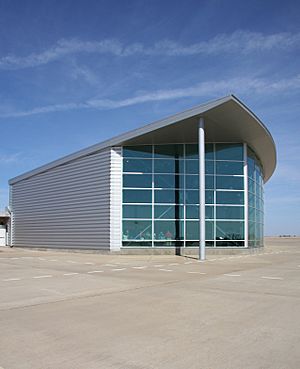
Every year on July 4, Lubbock hosts the 4th on Broadway event, an Independence Day festival. The event is free to the public, and is considered the largest free festival in Texas. The day's activities usually include a morning parade, a street fair along Broadway Avenue with food stalls and live bands, the Early Settlers' Luncheon, and an evening concert/fireworks program. Broadway Festivals Inc., the non-profit corporation which organizes the event, estimated a 2004 attendance of over 175,000 people. Additionally, the College Baseball Foundation holds events relating to its National College Baseball Hall of Fame during the 4th on Broadway event.
The National Cowboy Symposium and Celebration, an annual event celebrating the prototypical Old West cowboy, takes place in Lubbock. The event, held in September, features art, music, cowboy poetry, stories, and the presentation of scholarly papers on cowboy culture and the history of the American West. A chuckwagon cook-off and horse parade also take place during the event.
Music
The west Texas arts scene have created a "West Texas Walk of Fame" located within Buddy and Maria Elena Holly Plaza in the historic Depot District which details musicians such as Buddy Holly who came from the local area. Lubbock continues to play host to rising and established alt-country acts at venues like the Cactus Theater and The Blue Light Live, both located on Buddy Holly Avenue. The spirit of Buddy Holly is preserved in the Buddy Holly Center in Lubbock's Depot District. The 2004 film Lubbock Lights showcased much of the music that is associated with the city of Lubbock.
Lubbock is the birthplace of rock and roll legend Buddy Holly and features a cultural center named for him. The city previously hosted an annual Buddy Holly Music Festival. The event was renamed Lubbock Music Festival after Holly's widow increased usage fees for his name. Similarly, the city renamed the Buddy Holly West Texas Walk of Fame to honor area musicians as the West Texas Hall of Fame. On January 26, 2009, the City of Lubbock agreed to pay Holly's widow $20,000 for the next 20 years to maintain the name of the Buddy Holly Center. Additionally, land near the center will be named the Buddy and Maria Holly Plaza. Holly's legacy is also remembered through the work of deejays, such as Jerry "Bo" Coleman, Bud Andrews, and Virgil Johnson on radio station KDAV.
Lubbock is also the birthplace of Morris Mac Davis (born January 21, 1942), also known as Mac Davis. Davis graduated at 16 from Lubbock High School and went on to become a country music singer, songwriter and actor, who has enjoyed much crossover success. His early work writing for Elvis Presley produced the hits "Memories", "In the Ghetto", and "A Little Less Conversation". A subsequent solo career in the 1970s produced hits, such as "Baby, Don't Get Hooked on Me" making him a well-known name in pop music. He also starred in his own variety show, a Broadway musical, and various films and TV shows.
Outsider musician and psychobilly pioneer The Legendary Stardust Cowboy was also born in Lubbock. He began his musical career there, playing free shows in various parking lots around town. Since striking it big, however, the Ledge has not performed in Lubbock, due to how little support and encouragement the city showed him when he was first starting out. John Denver got his start in Lubbock and as a freshman student at Texas Tech in 1966 could be found playing in the Student Union for free. His father was a Colonel in the Air Force stationed at Reese Air Force base west of the city.
The Lubbock Symphony Orchestra was founded in 1946 and performs at the Lubbock Memorial Civic Center Theatre.
Tourism
Lubbock's Memorial Civic Center hosts many events. Former Mayor Morris Turner (1931–2008), who served from 1972–1974, has been called the father of the Civic Center. Other past mayors include Jim Granberry and Roy Bass.
According to a study released by the nonpartisan Bay Area Center for Voting Research, Lubbock is the second-most conservative city in the United States among municipalities greater than 100,000 in population.
The National Ranching Heritage Center, a museum of ranching history, is located in Lubbock. It features a number of authentic early Texas ranch buildings, as well as a railroad depot and other historic buildings. An extensive collection of weapons is also on display. Jim Humphreys, late manager of the Pitchfork Ranch east of Lubbock, was a prominent board member of the center. The American Cowboy Culture Association, founded in 1989, is located in Lubbock; it co-hosts the annual National Cowboy Symposium and Celebration held annually from Thursday through Sunday after Labor Day.
The Southwest Collection, an archive of the history of the region and its surroundings which also works closely with the College Baseball Foundation, is located on the campus of Texas Tech University, as are the Moody Planetarium and the Museum of Texas Tech University.
The Depot District, an area of the city dedicated to music and nightlife located in the old railroad depot area, boasts a number of theatres, upscale restaurants, and cultural attractions. The Depot District is also home to several shops, pubs and nightclubs, a radio station, a magazine, a winery, a salon, and other establishments. Many of the buildings were remodeled from the original Fort Worth & Denver South Plains Railway Depot which originally stood on the site. The Buddy Holly Center, a museum highlighting the life and music of Buddy Holly, is also located in the Depot District, as is the restored community facility, the Cactus Theater.
Lubbock is also home to the Silent Wings Museum. Located on North I-27, Silent Wings features photographs and artifacts from World War II-era glider pilots.
The Science Spectrum is an interactive museum and IMAX Dome theatre with a special focus on children and youth.
National Register of Historic Places
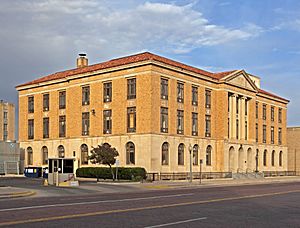
- Cactus Theater
- Canyon Lakes Archaeological District
- Carlock Building
- Fort Worth and Denver South Plains Railway Depot
- Fred and Annie Snyder House
- Holden Properties Historic District
- Kress Building
- Lubbock High School
- Lubbock Lake Landmark
- Lubbock Post Office and Federal Building
- South Overton Residential Historic District
- Texas Technological College Dairy Barn
- Texas Technological College Historic District
- Tubbs-Carlisle House
- Warren and Myrta Bacon House
- William Curry Holden and Olive Price Holden House
Parks and recreation
In March 1877, during the Buffalo Hunters' War, the Battle of Yellow House Canyon took place at what is now the site of Mackenzie Park. Today, Mackenzie Park is home to Joyland Amusement Park, Prairie Dog Town, and both a disc golf and regular golf course. The park also holds the American Wind Power Center, which houses over 100 historic windmills on 28 acres (11 hectares). Two tributaries of the Brazos River wind through Mackenzie Park, which is collectively part of the rather extensive Lubbock Park system. These two streams, (Yellow House Draw and Blackwater Draw), converge in the golf course, forming the head of Yellow House Canyon, which carries the waters of the North Fork Double Mountain Fork Brazos River.
Sister cities
Current sister cities
Former sister cities
 City of León, Guanajuato, Mexico – relationship established 1985
City of León, Guanajuato, Mexico – relationship established 1985
Proposed sister cities
 City of Can Tho, Vietnam
City of Can Tho, Vietnam City of Ulsan, South Korea
City of Ulsan, South Korea Ciudad Acuña, Mexico
Ciudad Acuña, Mexico
Economy
The Lubbock area is the largest contiguous cotton-growing region in the world and is heavily dependent on federal government agricultural subsidies and on irrigation water drawn from the Ogallala Aquifer. The aquifer is being depleted at a rate unsustainable over the long term. Much progress has been made toward water conservation, and new technologies such as low-energy precision application irrigation were originally developed in the Lubbock area. A new pipeline from Lake Alan Henry is expected to supply up to 3.2 billion US gallons (12,000,000 m3; 12 GL) of water per year.
Adolph R. Hanslik, who died in 2007 at the age of 90, was called the "dean" of the Lubbock cotton industry, having worked for years to promote the export trade. Hanslik was also the largest contributor (through 2006) to the Texas Tech University Medical Center. He also endowed the Texas Czech Heritage and Cultural Center's capital campaign for construction of a new library museum archives building in La Grange in Fayette County in his native southeastern Texas.
The 10 largest employers in terms of the number of employees are Texas Tech University, Covenant Health System, Lubbock Independent School District, University Medical Center, United Supermarkets, City of Lubbock, Texas Tech University Health Sciences Center, AT&T, and Lubbock County. A study conducted by a professor at the Rawls College of Business determined Texas Tech students, faculty, and staff contribute about $1.5 billion to the economy, with about $297.5 million from student shopping alone.
Lubbock has one regional enclosed mall, South Plains Mall, and many open-air shopping centers, most on the city's booming southwestern side. Lubbock is also home to furniture retailers, such as Spears Furniture, which has been in Lubbock since 1950. Lubbock's newest open-air shopping center is Canyon West at the intersection of Milwaukee Avenue and Marsha Sharp Freeway.
As of 2014, a new shopping center on West Loop 289 began development, including the opening of two anchor stores, Cabela's in 2014 and Costco in 2013.
Economic development
Founded as Market Lubbock in 1997, the city created the Lubbock Economic Development Alliance to recruit new business and industry to Lubbock and to retain existing companies. Its mission is to promote economic growth through the creation of high-quality jobs, attract new capital investment, retain and expand existing businesses, and improve Lubbock's quality of life.
Environmental issues
The Scrub-A-Dubb Barrel Company, in the north of the city, had been the cause of public complaints, and committed numerous environmental violations, since the 1970s. Local KCBD News undertook several investigations into the barrel recycling company's waste-handling practices, and when the business closed in 2011, the Environmental Protection Agency was called in to begin cleaning up the site, which they described as "a threat to public health, welfare, and the environment". Greg Fife, the EPA's on-site coordinator, said: "Out of the 60,000 [barrels] we have on site, we think there are between 2,000 and 4,000 that have significant hazardous waste in them". Local residents were informed, "hazardous substances have overflowed the vats and flowed off the site into nearby Blackwater Draw and subsequently through Mackenzie recreational park. The runoff is easily accessible to children at play in the park, golfers, and the park's wildlife." Remediation of the site was expected to take at least five months, at a cost of $3.5 million in federal dollars.
Sports
The Texas Tech Red Raiders are in the Big 12 Conference and field 17 teams in 11 different varsity sports. Men's varsity sports at Texas Tech are baseball, basketball, cross country, football, golf, tennis, and indoor and outdoor track and field. Women's varsity sports are basketball, cross country, golf, indoor and outdoor track and field, soccer, softball, tennis, and volleyball. The university also offers 30 club sports, including cycling, equestrianism, ice hockey, lacrosse, polo, rodeo, rugby, running, sky diving, swimming, water polo, and wrestling. In 2006, the polo team, composed of Will Tankard, Ross Haislip, Peter Blake, and Tanner Kneese, won the collegiate national championship.
The football program has been competing since October 3, 1925. The Red Raiders have won 15 conference titles and been to 50 bowl games, winning five of the last seven.
The men's basketball program, started in 1925, has been to the NCAA Tournament 18 times—advancing to the Sweet 16 seven times, and the Elite Eight twice, and in 2019 they reached the Final Four and were the NCAA Tournament Runner-Up under coach Christ Beard. Bob Knight, hall-of-famer and second-winningest coach in men's college basketball history, coached the team from 2001 to 2008.
Of the varsity sports, Texas Tech has had its greatest success in women's basketball. Led by Sheryl Swoopes and head coach Marsha Sharp, the Lady Raiders won the NCAA Women's Basketball Championship in 1993. The Lady Raiders have also been to the NCAA Elite Eight three times and the NCAA Sweet 16 seven times. In early 2006, Lady Raiders coach Marsha Sharp resigned and was replaced on March 30, 2006, by Kristy Curry, who had been coaching at Purdue.
In addition, Lubbock is the home of the Chaparrals of Lubbock Christian University. With a recent move up to NCAA Division 2, the women's basketball team has won the 2016 and 2019 national championships. In 2009, the Lubbock Christian University baseball team won their second NAIA National Championship.
High-school athletics also feature prominently in the local culture.
Semi-professional teams
The Lubbock Renegades, a member of the af2, a developmental league of the Arena Football League, were in operation from 2006 to 2008.The team played in the former Lubbock Memorial Coliseum.
The Lubbock Cotton Kings, of the former Central Hockey League, operated from 1999 to 2007.
In 2021, National Premier Soccer League announced the formation of the Lubbock Matadors in the 2022 season.
Little League
In 2007, the Lubbock Western All-Stars Little League Baseball team made it to the final four of the Little League World Series.
Education
Schools
Schools in Lubbock are operated by several public school districts and independent organizations.
Public schools:
- Lubbock Independent School District
- Frenship Independent School District
- Lubbock-Cooper Independent School District
- Roosevelt Independent School District
Private schools:
- All Saints Episcopal School
- Christ the King Cathedral School
- Trinity Christian School
- Lubbock Christian School
- Kingdom Preparatory Academy
- Southcrest Christian School
Charter schools:
- Harmony Science Academy
- Sharp Academy
Higher education
Lubbock is home to Texas Tech University, which was established on February 10, 1923, as Texas Technological College. It is the leading institution of the Texas Tech University System and has the seventh-largest enrollment in the state of Texas. It is one of two schools (the other being UT Austin) in Texas to house an undergraduate institution, law school, and medical school at the same location. Altogether, the university has educated students from all 50 US states and over 100 foreign countries. Enrollment has continued to increase in recent years, and growth is on track with a plan to have 40,000 students by 2020.
Lubbock is also home to other college campuses in the city, including Lubbock Christian University, South Plains College, Wayland Baptist University, and Sunset International Bible Institute.
Covenant Health System, a health-care provider serving West Texas and Eastern New Mexico, operates a school of nursing, school of radiography, and school of surgical technology.
Infrastructure
The Texas Department of Criminal Justice operates the Lubbock District Parole Office in Lubbock.
The Texas Department of Transportation operates the West Regional Support Center and Lubbock District Office in Lubbock.
The United States Postal Service operates post offices in Lubbock.
Transportation
Highways
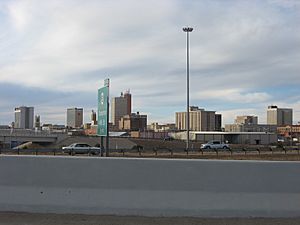
Lubbock is served by major highways. Interstate 27 (the former Avenue H) links the city to Amarillo and Interstate 40, a transcontinental route. I-27 was completed through the city in 1992 (it originally terminated just north of downtown). Other major highways include US 62 and US 82, which run concurrently (except for 4th Street (82) and 19th Street (62)) through the city east–west as the Marsha Sharp Freeway, 19th Street (62 only), 4th Street/Parkway Drive (82 only) and Idalou Highway. US 84 (Avenue Q/Slaton Highway/Clovis Road) is also another east–west route running NW/SE diagonally. US Highway 87 runs between San Angelo and Amarillo and follows I-27 concurrently. State Highway 114 runs east–west, following US 62/82 on the east before going its own way. Lubbock is circled by Loop 289, which suffers from traffic congestion despite being a potential bypass around the city, which is the reason behind I-27 and Brownfield Highway being built through the city to have freeway traffic flow effectively inside the loop.
The city is set up on a simple grid plan. In the heart of the city, numbered streets run east–west and lettered avenues run north–south – the grid begins at Avenue A in the east and First Street in the north. North of First Street, city planners chose to name streets alphabetically from the south to the north after colleges and universities. The north–south avenues run from A to Y. What would be Avenue Z is actually University Avenue, since it runs along the east side of Texas Tech. Beyond that, the A-to-Z convention resumes, using US cities found east of the Mississippi (e.g. Akron Avenue, Boston Avenue, Canton Avenue). Again, the Z name is not used, with Slide Road appearing in its place.
Rail service
Lubbock currently does not provide intercity rail service, although various proposals have been presented over the years to remedy this. One, the Caprock Chief, would have seen daily service as part of a Fort Worth, Texas—Denver, Colorado service, but it failed to gain interest. Lubbock is served by the BNSF Railway company, Plainsman Switching Company (PSC), and West Texas & Lubbock Railway (WTLC). PSC interchanges with BNSF (also with UP through a UP-BNSF Haulage agreement) in Lubbock and has 19 miles of track within city limits of Lubbock with 36 customers. Options exist for transloading a variety of materials on the line, from wind-turbine parts to steel shafts. PSC handles many commodities such as cottonseed, cottonseed oil, cottonseed meal, cottonseed hulls, milo, corn, wheat, pinto beans, sand, rock, lumber, nonperishable food items, chemicals, paper products, brick, and bagging material, and can also store cars. WTLC interchanges with BNSF (also with UP through a UP-BNSF Haulage agreement) in Lubbock. WTLC has a yard on the west side of Lubbock, where they switch cars to go down their line to Levelland or to Brownfield. WTLC handles commodities of grains, chemicals, sands, peanuts, lumber, etc.
Airports
The city's air services are provided by Lubbock Preston Smith International Airport, which is named for the Lubbock businessman who became lieutenant governor and governor of Texas. It is on the city's northeast side. The airport is the eighth-busiest airport in Texas. Lubbock Preston Smith Airport also plays host as a major hub to FedEx's feeder planes that serve cities around Lubbock.
Intercity bus service
Greyhound Lines operates the Lubbock Station at 801 Broadway, just east of the Lubbock County Courthouse.
Public transportation
Public transportation is provided by Citibus, a bus transit system running Monday through Saturday every week with a transit center hub in downtown. It runs bus routes throughout the city, with the main routes converging at the Downtown Transfer Plaza, which also houses the Greyhound bus terminal. Citibus has been in continual service since 1971, when the city of Lubbock took over public transit operations. The paratransit system is called Citiaccess.
Citibus' six diesel-electric hybrid buses have begun service on city routes. Managers hope the buses will use 60% of the fuel their older, larger versions consume in moving customers across the city. The buses seat 23 passengers, can support full-sized wheelchairs, and will run on all but two city-based routes.
Modal characteristics
According to the 2016 American Community Survey, 80.9% of working Lubbock (city) residents commuted by driving alone, 12.9% carpooled, 1% used public transportation, and 1.5% walked. About 1.5% used all other forms of transportation, including taxi, bicycle, and motorcycle. About 2.3% worked at home.
In 2015, 7.3% of Lubbock households were without a car, which decreased to 5.6% in 2016. The national average was 8.7% in 2016. Lubbock averaged 1.74 cars per household in 2016, compared to a national average of 1.8 per household.
Milwaukee Avenue
In the early years of the 21st century, Lubbock turned its Milwaukee Avenue into a major thoroughfare. Previously, Milwaukee was a 4-mile dirt road on farm land with hardly any traffic a mile or more from major development. With growth headed westward, the city allocated nearly $20 million to convert the road into a seven-lane concrete thoroughfare. In 2004, the city funded the project and other developments to come by establishing a new fund that tapped part of the franchise fees received. As of 2018, more than $124 million in street construction has been possible from the fund, including Slide Road, 98th Street, Indiana Avenue, and the last phases of the Marsha Sharp Freeway. Public Works Director Wood Franklin said Milwaukee Avenue was conceived on the "build it and they will come" theory. Marc McDougal, then the mayor of Lubbock, described the project as a well calculated risk that subsequently greatly benefited the city.
Notable people
Arts and science
- Chace Crawford, actor, notable for roles in The Covenant and Gossip Girl
- Dan Flores, a writer and historian who specializes in cultural and environmental studies of the American West who began his academic career at Texas Tech University
- Bryan A. Garner, Lawyer, lexicographer, and teacher. J. Michael Bailey, psychologist and professor at Northwestern University, was born in Lubbock
- Jill Goodacre, model and actress
- Rick Husband, Astronaut and graduate from Texas Tech University
- Joshua Meyer, artist
- Gabor B. Racz, professor of anesthesiology at Texas Tech University Health Science Center, is the inventor of the Racz catheter
- Wayne Tippit (1932-2009), American television and stage character actor
- Erik Valdez, actor
- Helen Wagner (1918-2010), television actress (As the World Turns)
- Spencer Wells, a geneticist, grew up in Lubbock and graduated from Lubbock High School
- Kevin Williamson, National Review roving correspondent, grew up in Lubbock and once worked for the Lubbock Avalanche-Journal
- Micah Wright, author
Military
- Taylor Force late United States Army officer after whom the Taylor Force Act was named
Music
- Josh Abbott, singer of Texas country band Josh Abbott Band
- Terry Allen, Texas country and outlaw country singer-songwriter, painter and conceptual artist
- Ponty Bone, singer, accordion player
- Wade Bowen, Texas Country/Red Dirt singer
- Mac Davis, country music singer, songwriter, and actor
- Travis Garland of the band NLT
- Jimmie Dale Gilmore, Butch Hancock, and Joe Ely (collectively known as The Flatlanders)
- Pat Green, Texas country music artist
- Buddy Holly, musician and singer-songwriter who was a central and pioneering figure of mid-1950s rock and roll
- Bobby Keys, saxophonist
- Logan Lynn, singer, musician, writer, composer, singer, producer
- Lloyd Maines of The Maines Brothers Band
- Natalie Maines singer of the band The Chicks
- Delbert McClinton American blues rock and electric blues singer-songwriter, guitarist, harmonica player, and pianist
- Richie McDonald, lead singer of Lonestar until 2007
- Kevin Morby, indie folk singer-songwriter
- Cory Morrow, Texas country singer-songwriter
- Daron Norwood, American 90's country singer, signed to Giant
- Norman Carl Odam (aka The Legendary Stardust Cowboy)
- Pete Orta of the Christian rock group Petra
- Amanda Shires, singer-songwriter and fiddle player
- Josh Wilson, a contemporary Christian musician.
- Flatland Calvary, a country and Americana band.
Sports
- Ruben Castillo, boxer
- Madisyn Cox, competitive swimmer
- Mason Crosby, American football placekicker for the Green Bay Packers of the National Football League (NFL)
- Craig Ehlo, basketball player
- Anthony Lynn, American football head coach of the Los Angeles Chargers who coached at Texas Tech University
- Greg Minton, former Major League Baseball pitcher
- Donnie Moore, baseball player
- Terry Norris, boxer
- Orlin Norris, boxer
- Mark Payne is an American professional basketball player who plays for Champagne Châlons Reims Basket of the LNB Pro A
- Ron Reeves, former American football quarterback
- Micheal Ray Richardson, basketball player and coach
- Daniel Santiago, former professional basketball player
- W. E. Shattuc, who raced in the Indianapolis 500 in 1925, 1926, and 1927
- Ryan Tannehill, quarterback for the Miami Dolphins and later, the Tennessee Titans
- Don Wayne (Bubba Shobert), National Motorcycle Champion
- Trae Young, point guard for the Atlanta Hawks
Images for kids
See also
 In Spanish: Lubbock para niños
In Spanish: Lubbock para niños



